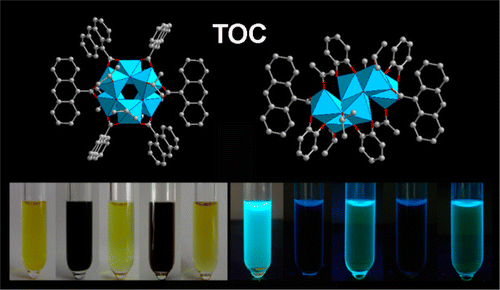Titanium–Oxo Cluster with 9-Anthracenecarboxylate Antennae: A Fluorescent and Photocurrent Transfer Material
Yin-Yin Wu †
† College of Chemistry, Chemical Engineering and Materials Science, Soochow University, Suzhou 215123, People’s Republic of China
‡ State Key Laboratory of Coordination Chemistry, Nanjing University, Nanjing 210093, People’s Republic of China
Inorg. Chem. 2014, 53, 7233–7240
Attention has been paid to titanium–oxo clusters (TOCs) modified with functional molecules, because they can be considered as model systems for dye-sensitized titanium oxides in terms of their information in structures and electron transfer. We select 9-anthracenecarboxylate (9-AC) as a photoactive ligand and prepare two model compounds, [Ti6O6(OiPr)6(9-AC)6] (1) and [Ti6O4(OiPr)6(cat)4(9-AC)2] (2) (where cat = catecholate). Structures of the TOCs and the dye–TOC linkage are characterized by single-crystal analysis. Solvent-induced fluorescence change is observed for the cluster solution, and the fluorescence can be turned off by irradiating and on by oxygen bubbling. Photoinduced Ti(III) is responsible for the fluorescence extinction. The photocurrent conversion property of the clusters is examined by use of a three-electrode cell with cluster-coated indium tin oxide (ITO) electrodes. The results indicate that 9-AC is an effective photosensitizer and cluster 1 shows higher photocurrent intensity for its multiantenna structure in comparison with that of 2. Density of states for cluster 1 is calculated, in which the discrete energy bands of Ti6O24 include a number of new energy levels for the contribution of 9-AC molecules.

链接: //pubs.acs.org/doi/abs/10.1021/ic500390j